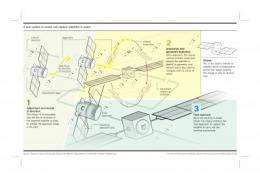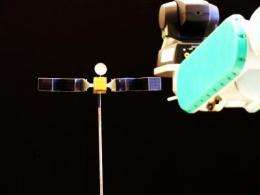A new system for locating and capturing satellites in space

Spanish scientists at the Universidad Carlos III de Madrid have developed a new system for docking and capturing space satellites based on robotics and computer vision technology to autonomously guide a space vehicle to dock and capture the satellites.
Within the framework of this research project, "Acoplamiento y Agarre de Satélites mediante Sistemas Robóticos basado en Visión (Docking and Capture of Satellites through computer vision) (ASIROV)", the scientists have developed algorithms and strategies to dock and capture a disabled satellite through the use of a space vehicle, called a "chaser", which autonomously carries out this function. "In this way", explained the head of this research study, Mohamed Abderrahim, who is from the UC3M Department of Automated Systems Engineering, "we attempt to carry out all the phases of a satellite inspection and maintenance mission with another autonomous vehicle equipped with a robotic system for capture and control".
What is most outstanding about the designed prototype is its algorithmic part, according to the researchers, as they are not involved with the manufacture or launching of satellites. Their true contribution lies in the set of well-defined and ordered instructions which allow satellites to be programmed for the future so they can service others which have become disabled or which allow them to prolong the satellite's working life. These navigation algorithms, based on vision techniques, are capable of indentifying the objects of the search among various objects present, estimating their position and orientation.

In their research, given that the system cannot be tested in a real platform, the scientists have constructed a small bank of tests which allow them to simulate a scenario of this kind. They first designed vision algorithms which employ satellite model vertices as characteristic points. Then, they perfected the technique to design a new vision algorithm that uses the information about the texture around the points of interest of the image to associate them with the points in the model. "The latter technique is quite robust against noise, changes in the background and variations in illumination", Abderrahim noted. Furthermore, he stated, "that the speed of the algorithm allows it to be used in real time".
The idea behind this research came up thanks to the relation between the UC3M Robotics Lab and the engineers of the company GMV, which is dedicated to the space sector, and the existing need in the market for a system of this kind. "Today there is a growing need to provide satellite maintenance services, without relying on manned missions, which are very costly and involve risks. Robotics is the natural solution", Professor Abderrahim concluded.
The researchers are in contact with the Spanish company, SENER, as they explore paths for collaboration to implement this idea, with the aim of extending the working life of communication satellites to up to twelve years of service in space. In addition, all of the knowledge acquired within the framework of this research project, in which Julio César Díaz, Claudio Rossi, Nicolás Burrus and Marcos Iglesias have also participated –has been included as classroom material in the university subject, Robotics in Space, within the UC3M Master's Degree Program in Robotics and Automation.
Provided by Carlos III University of Madrid



















